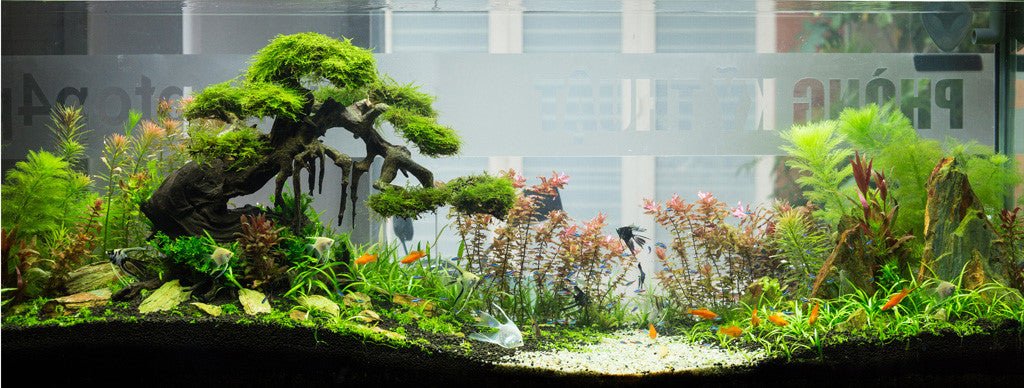Cleaning freshwater fish tank plants is essential. It keeps your aquarium healthy.
Plants can gather algae and debris over time. Regular cleaning ensures they thrive and your fish stay happy. This guide will show you simple steps to clean your tank plants. You’ll learn the best techniques and tools to use. Maintaining clean plants helps in keeping water quality high.
It also prevents diseases in your fish. Whether you’re a beginner or an experienced aquarist, these tips will help. Dive in to discover how to make your tank plants look their best.
:strip_icc()/cleaning-aquarium-plants-1381082_Final-5bc0f558c9e77c0051b23823.png)
Credit: www.thesprucepets.com
Introduction To Plant Care
Taking care of freshwater fish tank plants is essential. It helps maintain a healthy aquatic environment. Clean plants ensure good water quality and happy fish. This guide will help you understand how to keep your tank plants clean and thriving.
Importance Of Clean Plants
Clean plants are vital for a healthy aquarium. They help in oxygen production and waste removal. Dirty plants can harbor harmful bacteria and algae. This can affect water quality and harm your fish. Keeping plants clean also enhances the beauty of your tank.
Common Plant Types
Various types of plants thrive in freshwater tanks. Here are some common ones:
| Plant Type | Description |
|---|---|
| Java Fern | Easy to care for and grows slowly. |
| Anubias | Hardy plant that grows well in low light. |
| Amazon Sword | Popular choice with large, broad leaves. |
| Hornwort | Fast-growing and helps reduce algae. |
Each plant type has unique care needs. Here are some general tips:
- Trim dead or decaying leaves regularly.
- Rinse plants with dechlorinated water.
- Check for pests and remove them promptly.
- Avoid using harsh chemicals on plants.
- Provide adequate light and nutrients.
Following these tips will help keep your plants healthy. Healthy plants contribute to a vibrant and thriving aquarium.
Preparing For Cleaning
Cleaning freshwater fish tank plants is vital for a healthy aquarium. Proper preparation ensures the process goes smoothly and efficiently. Let’s break down the steps to get ready for cleaning.
Gathering Supplies
Before you start, gather all necessary supplies. This will save time and make the job easier.
- Buckets: Use clean buckets to hold water and plants.
- Soft Brush: A soft brush helps clean delicate plants without damage.
- Scissors: Use sharp scissors to trim dead or excess plant parts.
- Dechlorinated Water: Rinse plants with dechlorinated water to avoid harming them.
- Towels: Keep towels handy to dry your hands and any spills.
Setting Up A Workspace
Find a suitable workspace before you begin cleaning. A well-organized area keeps things neat and stress-free.
- Choose a Flat Surface: Select a table or counter with enough space for all supplies.
- Ensure Good Lighting: Proper lighting helps you see and clean plants thoroughly.
- Protect the Surface: Use a plastic sheet or old towel to protect your workspace from water and dirt.
- Keep Tools Within Reach: Arrange all supplies within arm’s reach for easy access.
By gathering supplies and setting up a workspace, you are ready to clean your freshwater fish tank plants efficiently and effectively.
Removing Plants From Tank
Cleaning your freshwater fish tank plants is essential for their health. The first step is to remove the plants from the tank. This process needs to be done carefully to avoid harming the plants or disturbing your fish. Follow these steps to ensure a smooth and safe removal.
Safely Extracting Plants
Before starting, prepare a clean container filled with tank water. This will keep the plants moist while you clean them. Turn off any equipment that may obstruct you, such as filters or heaters.
Gently grasp the base of the plant near the substrate. Slowly lift the plant, ensuring the roots come out intact. If the roots are tangled, use a gentle twisting motion to free them.
Handling With Care
Handle each plant with care to prevent damage. Use both hands for larger plants to support their weight. For smaller plants, a gentle touch is enough.
Avoid pulling too hard, as this can tear the roots. If a plant is stubborn, use a small, soft brush to loosen the substrate around the roots.
Keep the plants moist by spraying them with tank water if they start to dry out. This helps maintain their health while they are out of the tank.
| Step | Action |
|---|---|
| 1 | Prepare a clean container with tank water |
| 2 | Turn off obstructing equipment |
| 3 | Gently grasp the plant base |
| 4 | Lift the plant slowly |
| 5 | Use a twisting motion if roots are tangled |
| 6 | Handle with care to avoid damage |
| 7 | Keep plants moist while out of the tank |
:strip_icc()/cleaning-aquarium-plants-1381082-hero-023647932fb74728b52b036d8d3b52e5.jpg)
Credit: www.thesprucepets.com
Cleaning Tools And Techniques
Cleaning your freshwater fish tank plants is essential for maintaining a healthy aquarium environment. Using the right cleaning tools and techniques ensures that your plants remain vibrant and free from algae. Below, we will explore some effective methods to keep your tank plants clean.
Using Soft Brushes
Soft brushes are excellent for cleaning delicate plant leaves. They help remove dirt without damaging the plants. Here are some steps:
- Choose a brush with soft bristles.
- Gently brush the leaves to remove debris.
- Rinse the plants in clean water after brushing.
Soft brushes are also useful for cleaning plant stems. Brush in a downward motion to avoid breaking the stems.
Utilizing Algae Scrapers
Algae scrapers are essential for removing stubborn algae from plant surfaces. They come in various types:
| Type | Usage |
|---|---|
| Metal Scrapers | For tough algae on hard surfaces. |
| Plastic Scrapers | For softer algae on delicate plants. |
Follow these steps to use algae scrapers effectively:
- Select the appropriate scraper for your plants.
- Gently scrape the algae off the plant surfaces.
- Rinse the plants thoroughly to remove any algae residue.
Regular use of algae scrapers can help keep your plants clean and healthy.
Rinsing And Soaking
Cleaning your freshwater fish tank plants is essential. It keeps the tank healthy. Rinsing and soaking the plants can help remove dirt, algae, and harmful chemicals. Let’s break this down into easy steps.
Freshwater Rinse
Start by rinsing your plants with freshwater. Follow these steps:
- Remove the plants from the tank.
- Hold each plant under running water.
- Gently rub the leaves to remove dirt and algae.
Use lukewarm water. Cold water can shock the plants. Make sure to rinse both sides of each leaf. This ensures a thorough clean.
Using Safe Solutions
Sometimes, rinsing alone is not enough. You may need to use safe solutions. Here’s how:
- Prepare a soaking solution with water and aquarium-safe cleaner.
- Soak the plants in this solution for 10-15 minutes.
- Rinse the plants again with freshwater.
Do not use harsh chemicals. They can harm your plants and fish. Always read the label on any cleaner you use.
Here’s a quick comparison of safe solutions:
| Solution | Usage | Notes |
|---|---|---|
| Aquarium-safe cleaner | Soak for 10-15 minutes | Read the label |
| Vinegar and water mix | Soak for 5-10 minutes | Rinse thoroughly |
After soaking, inspect the plants. Make sure they are clean and free of debris.
Inspecting For Pests
Keeping your freshwater fish tank plants clean is essential. One key aspect is to inspect for pests. These pests can harm your plants and fish. Regular checks will help you identify and treat pests before they cause significant damage.
Identifying Common Pests
Knowing what pests to look for is crucial. Here are some common pests you might find on your freshwater plants:
- Snails: Small, slow-moving creatures that leave a slimy trail.
- Aphids: Tiny insects that often cluster on new growth.
- Algae: Green or brown substances that cover plant surfaces.
- Fish Lice: Small, flat parasites that attach to fish and plants.
Treating Infestations
If you find pests, it’s important to treat them quickly. Here are some steps:
- Manual Removal: Use tweezers or a soft brush to remove visible pests.
- Quarantine: Isolate affected plants to prevent the spread.
- Chemical Treatments: Use safe, fish-friendly pesticides. Always read the label.
- Natural Predators: Introduce fish or snails that eat the pests.
Regular inspections and prompt treatment will help keep your tank healthy. Always monitor your plants and fish for any signs of new infestations.
Replanting In The Tank
Once your freshwater fish tank plants are clean, it’s time to replant them. Replanting is a crucial step to ensure your plants thrive and your tank looks beautiful. Let’s dive into the best practices for replanting your tank plants.
Optimal Placement
Choosing the right spot for each plant is essential. Consider the plant’s needs such as light and space. Some plants need more light, while others thrive in shaded areas. Place taller plants at the back and shorter plants in the front. This arrangement allows all plants to get adequate light and keeps your tank visually appealing.
| Plant Type | Light Requirement | Placement |
|---|---|---|
| Amazon Sword | Moderate to high | Back or middle |
| Anubias | Low to moderate | Front or middle |
| Java Moss | Low | Front or attached to decor |
Create a balanced look by mixing different plant types. Use a variety of shapes, sizes, and colors. This creates a natural and attractive environment for your fish.
Securing Plants
Properly securing your plants is vital. It ensures they stay in place and grow healthily. Here are some tips:
- Use plant weights: Wrap weights around the base of the plant to anchor it.
- Plant deeply: Bury the roots well into the substrate. This provides stability.
- Use aquarium-safe glue: Attach plants like Java Moss to rocks or driftwood.
- Consider plant anchors: These are small clips that hold plants down.
Avoid burying the crown of the plant. This is where the stem meets the roots. Burying the crown can cause the plant to rot. Ensure the crown is above the substrate.
Monitor your plants after replanting. Check if they remain in place and start to grow. Adjust if necessary.
Replanting your freshwater tank plants correctly ensures a vibrant and healthy aquarium. Follow these steps for best results.
Maintenance Tips
Keeping your freshwater fish tank plants clean is crucial for a healthy aquarium. Regular maintenance helps prevent diseases and promotes growth. Here are some effective tips to ensure your plants thrive.
Regular Cleaning Schedule
Establishing a regular cleaning schedule is vital. Aim to clean your tank and plants every two weeks. This frequency helps remove debris and prevents the build-up of harmful substances.
- Weekly checks: Remove dead leaves and trim overgrown plants.
- Bi-weekly cleaning: Use a soft brush to clean the leaves and stems.
- Monthly deep clean: Gently remove plants and rinse them in tank water.
Consistency in cleaning ensures your plants receive the nutrients they need.
Preventing Algae Growth
Algae growth can be a major issue in fish tanks. To prevent algae, follow these tips:
- Control light exposure: Limit tank lighting to 8-10 hours daily.
- Maintain water quality: Regularly test and change the water.
- Introduce algae-eating fish: Species like Otocinclus help control algae.
Another effective method is to avoid overfeeding fish. Excess food can lead to algae growth.
| Tip | Frequency |
|---|---|
| Clean leaves and stems | Bi-weekly |
| Trim overgrown plants | Weekly |
| Control light exposure | Daily |
Following these tips will keep your freshwater fish tank plants healthy and algae-free.
Troubleshooting Issues
Maintaining a clean and healthy freshwater fish tank requires regular attention. Sometimes, despite your best efforts, you might face some common issues. This section will help you troubleshoot and address these problems to keep your tank plants thriving.
Dealing With Cloudy Water
Cloudy water can be frustrating. It often indicates an imbalance in your tank. Here are a few steps to tackle this issue:
- Check your filter: Ensure it’s working correctly and clean it if needed.
- Monitor feeding: Overfeeding can cause cloudiness. Feed your fish only what they can consume in a few minutes.
- Change water: Perform partial water changes (about 25%) weekly to maintain clarity.
- Test water parameters: Use a water testing kit to check ammonia, nitrites, and nitrates levels.
Addressing Plant Decay
Plant decay can affect the overall health of your tank. Follow these steps to manage and prevent plant decay:
- Inspect plants: Remove any dead or decaying leaves promptly.
- Check lighting: Ensure your plants receive adequate light. Different plants have different light requirements.
- Fertilize: Use an appropriate aquarium plant fertilizer to provide essential nutrients.
- Monitor CO2 levels: Adequate CO2 is crucial for plant growth. Consider a CO2 injection system if necessary.
- Prune regularly: Trim overgrown plants to promote healthy growth and prevent decay.
By addressing these common issues, you can ensure your freshwater fish tank plants remain healthy and vibrant. Regular maintenance and monitoring are key to a thriving aquatic environment.

Credit: www.aqueon.com
Frequently Asked Questions
How Often Should You Clean Freshwater Tank Plants?
Clean freshwater tank plants every 2-4 weeks. This prevents algae growth and keeps the plants healthy.
What Tools Are Needed To Clean Aquarium Plants?
Use soft brushes, algae scrapers, and plant-safe cleaning solutions. Avoid harsh chemicals that can harm the plants.
Can You Use Bleach To Clean Aquarium Plants?
Use diluted bleach solution for stubborn algae. Rinse thoroughly with dechlorinated water to avoid harming the plants.
How Do You Remove Algae From Aquarium Plants?
Gently scrub the plants with a soft brush. Rinse them with aquarium water to remove algae.
Conclusion
Keeping freshwater fish tank plants clean is essential. It ensures a healthy environment for fish. Regular cleaning prevents algae growth and keeps plants vibrant. Use gentle methods to avoid damaging the plants. A clean tank promotes better fish health and clearer water.
Consistency is key to maintaining plant beauty. Simple, regular care can make a big difference. Enjoy your clean, thriving freshwater tank. Happy fishkeeping!



